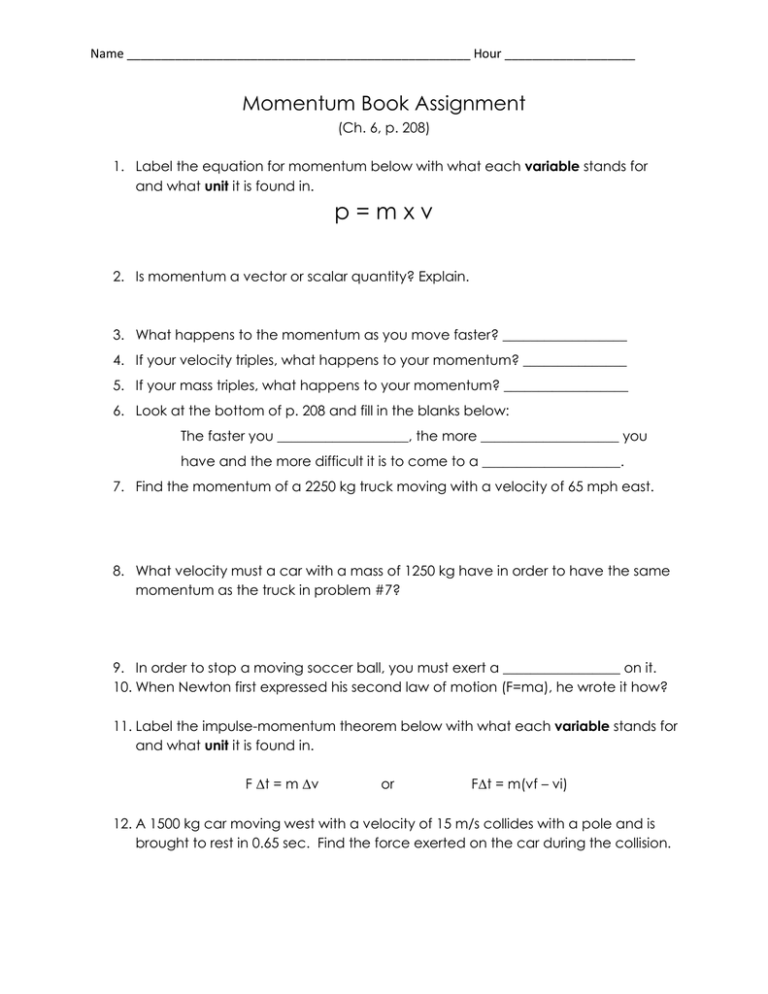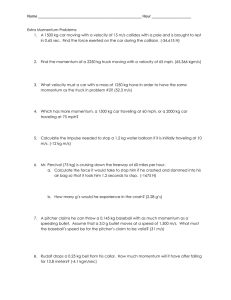Momentum Book Assignment
advertisement

Name __________________________________________________ Hour ___________________ Momentum Book Assignment (Ch. 6, p. 208) 1. Label the equation for momentum below with what each variable stands for and what unit it is found in. p=mxv 2. Is momentum a vector or scalar quantity? Explain. 3. What happens to the momentum as you move faster? __________________ 4. If your velocity triples, what happens to your momentum? _______________ 5. If your mass triples, what happens to your momentum? __________________ 6. Look at the bottom of p. 208 and fill in the blanks below: The faster you ___________________, the more ____________________ you have and the more difficult it is to come to a ____________________. 7. Find the momentum of a 2250 kg truck moving with a velocity of 65 mph east. 8. What velocity must a car with a mass of 1250 kg have in order to have the same momentum as the truck in problem #7? 9. In order to stop a moving soccer ball, you must exert a _________________ on it. 10. When Newton first expressed his second law of motion (F=ma), he wrote it how? 11. Label the impulse-momentum theorem below with what each variable stands for and what unit it is found in. F Δt = m Δv or FΔt = m(vf – vi) 12. A 1500 kg car moving west with a velocity of 15 m/s collides with a pole and is brought to rest in 0.65 sec. Find the force exerted on the car during the collision. Name __________________________________________________ Hour ___________________ 13. F Δt is called the ___________________________. So I = F Δt 14. Explain how an egg falling on a pillow has less force exerted on its shell than one falling on the table if they fall with the same momentum. (p. 214) 15. What does the law of conservation of momentum state? Restate it so it makes sense to you. (p. 216) Problems: (no book required) 1. Which has more momentum, a car traveling at 60 mph, or the same car traveling at 10 mph? 2. Which has more momentum, a 1500 kg car traveling at 60 mph, or a 2000 kg car traveling at 75 mph? 3. Calculate the impulse needed to stop a 1.2 kg water balloon if it is initially traveling at 10 m/s. 4. Mr. Percival (75 kg) is cruising down the freeway at 60 miles per hour. a. Calculate the force it would take to stop him if he crashed and slammed into his air bag so that it took him 1.2 seconds to stop. b. How many g’s would he experience in the crash? 5. A pitcher claims he can throw a 0.145 kg baseball with as much momentum as a speeding bullet. Assume that a 3.0 g bullet moves at a speed of 1,500 m/s. What must the baseball’s speed be for the pitcher’s claim to be valid? (31 m/s)








